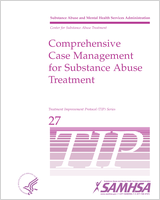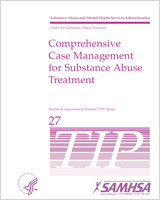NCBI Bookshelf. A service of the National Library of Medicine, National Institutes of Health.
This publication is provided for historical reference only and the information may be out of date.
This TIP, Comprehensive Case Management for Substance Abuse Treatment, presents an overview of case management for substance abuse treatment providers. Though they may not refer to it by name, many providers have been using case management for years. What studies support is also proven every day in the field - substance abusers have better treatment outcomes if their other problems are addressed concurrently. As case management becomes the subject of evaluation studies and is increasingly listed as a reimbursable service under managed care, however, more information and a more explicit framework are called for. Chapters 1 and 2 compare the leading models of case management and describe its various functions as practiced within the substance abuse treatment continuum. Chapter 3 provides guidance on establishing linkages with other service agencies, or intra-agency case management. Evaluation of programs, a crucial piece in getting case management funded under managed care, is explicated in Chapter 4. Chapter 5 explains how to use case management to serve an array of special needs substance abuse clients, including those with HIV/AIDS, mentally ill clients, and incarcerated clients. Practical information for adapting a treatment program to a managed care environment is given in Chapter 6. Appendix B is a comprehensive list of knowledge, skills, and attitudes that substance abuse counselors need to perform the case management activities of referral and service coordination. Appendix C is a readiness checklist for providers preparing for managed care.
Contents
- What Is a TIP?
- Editorial Advisory Board
- Consensus Panel
- Foreword
- Executive Summary
- Chapter 1 - Substance Abuse and Case Management: An Introduction
- Chapter 2 - Applying Case Management to Substance Abuse Treatment
- Chapter 3 - Case Management in the Community Context: An Interagency Perspective
- Chapter 4 - Evaluation and Quality Assurance of Case Management Services
- Chapter 5 - Case Management for Clients With Special Needs
- Minority Clients
- Clients With HIV Infection and AIDS
- Clients With Mental Illness
- Homeless Clients
- Women With Substance Abuse Problems
- Adolescent Substance Abusers
- Clients in Criminal Justice Settings
- Clients With Physical Disabilities
- Gay, Lesbian, Transgendered, and Bisexual Clients
- Case Management in Rural Areas
- Chapter 6 - Funding Case Management in a Managed Care Environment
- Appendix A - Bibliography
- Appendix B - Practice Dimensions
- Appendix C - Managed Healthcare Organizational Readiness Guide and Checklist: Special Report By James B. Bixler, M.S
- Appendix D - Resource Panel
- Appendix E - Field Reviewers
- Exhibits
This publication is part of the Substance Abuse Prevention and Treatment Block Grant technical assistance program. This publication was written under contract number ADM 270-95-0013. Sandra Clunies, MS, ICADC, served as the CSAT Government project officer. Writers were Paddy Cook, Mary Lou Dogoloff, Linda Harteker, Anne E Nelson, Michelle M Paul, Deborah J Shuman, Marcia Mjoseth, Virginia Vitzthum, Elizabeth Hayes, Max Gilbert, Cara Smith, and Y-Lang Nguyen. Special thanks go to Richard C Rapp, MSW, Patrick Sullivan, PhD, Elizabeth A Peyton, Robert Walker, MSW, LCSW, BCD, Mary Smolenski, CRNP, EdD, MaryLou Leonard, Annie Thornton, Niyati Pandya, Rose M Urban, MSW, JD, CSAC, Mark Meschter, Jack Rhode, E Harold Corbin, III, and Wendy Carter for their considerable contributions to this document.
The opinions expressed herein are the views of the Consensus Panel members and do not reflect the official position of the U.S. Department of Health and Human Services (DHHS). No official support or endorsement of CSAT or DHHS for these opinions or for particular instruments or software that may be described in this document is intended or should be inferred. The guidelines in this document should not be considered substitutes for individualized patient care and treatment decisions.
- Prevention validation and accounting platform: a framework for establishing accountability and performance measures of substance abuse prevention programs.[J Drug Educ. 2000]Prevention validation and accounting platform: a framework for establishing accountability and performance measures of substance abuse prevention programs.Kim S, McLeod JH, Williams C, Hepler N. J Drug Educ. 2000; 30(1):1-143.
- Health and support service utilization patterns of American Indians and Alaska Natives diagnosed with HIV/AIDS.[AIDS Educ Prev. 2004]Health and support service utilization patterns of American Indians and Alaska Natives diagnosed with HIV/AIDS.Ashman JJ, Pérez-Jiménez D, Marconi K. AIDS Educ Prev. 2004 Jun; 16(3):238-49.
- Review Substance Use Disorder Treatment For People With Physical and Cognitive Disabilities[ 1998]Review Substance Use Disorder Treatment For People With Physical and Cognitive DisabilitiesCenter for Substance Abuse Treatment. 1998
- The value of case management in the publicly funded substance abuse treatment system. The perspective of program directors, case managers and clients.[Care Manag J. 2000]The value of case management in the publicly funded substance abuse treatment system. The perspective of program directors, case managers and clients.Shwartz M, Stone DA, Camp J, Mulvey KP, Kane M, Plough A. Care Manag J. 2000 Fall; 2(3):139-47.
- Review Treatment for HIV-Infected Alcohol and Other Drug Abusers[ 1995]Review Treatment for HIV-Infected Alcohol and Other Drug AbusersCenter for Substance Abuse Treatment. 1995
- Comprehensive Case Management for Substance Abuse TreatmentComprehensive Case Management for Substance Abuse Treatment
Your browsing activity is empty.
Activity recording is turned off.
See more...

